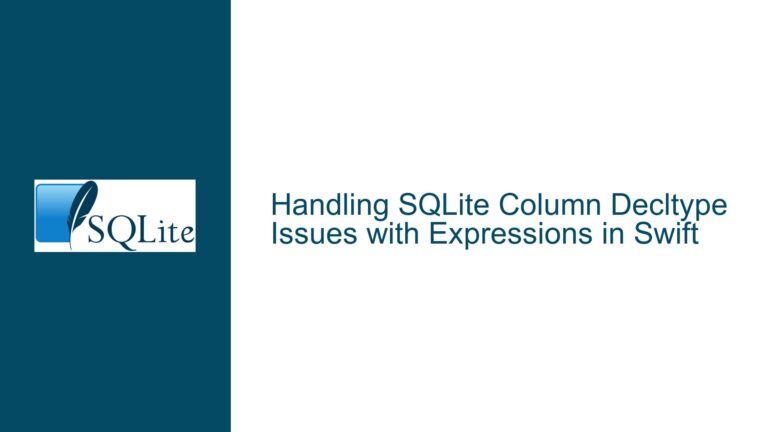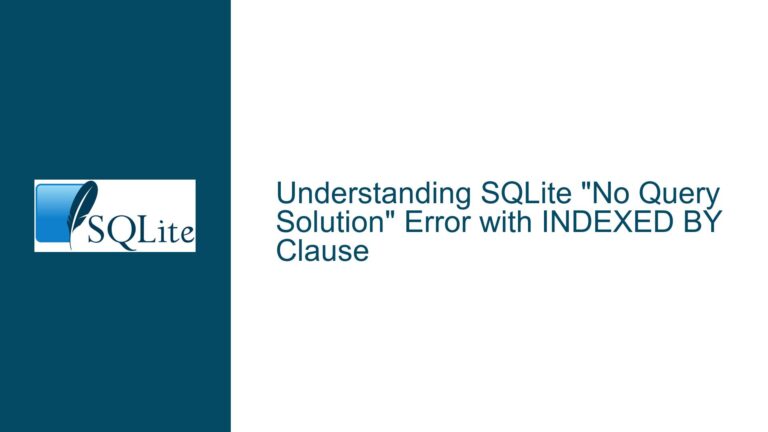NULL Values and Collation Sequences in SQLite: Guarantees and Behavior
SQLite’s Handling of NULL Values in Custom Collation Sequences
When working with custom collation sequences in SQLite, one of the most nuanced aspects is how NULL values are handled. Collation sequences are primarily designed to define the sorting order of text values, but the behavior of NULL values within these sequences is not always immediately clear. SQLite has specific rules for handling NULLs, and understanding these rules is critical for developers implementing custom collation logic.
In SQLite, NULL represents the absence of a value, and it is distinct from an empty string or a zero value. By design, NULL is not equal to anything, including itself. This inherent property of NULL makes it challenging to define a logical collation order for NULL values. However, SQLite provides explicit guarantees about how NULLs are treated in collation sequences, ensuring consistency and predictability in query results.
The core issue revolves around whether NULL values are passed to custom collation sequences and how SQLite ensures that NULLs are sorted consistently. SQLite guarantees that NULL values are never passed to custom collation sequences. Instead, NULLs are always sorted first, regardless of the collation sequence in use. This behavior is hardcoded into SQLite’s internal logic, as evidenced by the source code at line 1003 of main.c, where NULL values are explicitly handled before any collation logic is applied.
This design choice aligns with SQLite’s broader philosophy of simplicity and predictability. By handling NULLs at a lower level, SQLite ensures that custom collation sequences only need to deal with non-NULL text values, simplifying their implementation and reducing the potential for errors. Developers can therefore rely on SQLite to manage NULL sorting consistently, without needing to account for NULLs in their custom collation logic.
The Distinction Between NULL and Empty Strings in Collation Logic
A common point of confusion when working with collation sequences is the distinction between NULL values and empty strings. While both may appear similar at first glance, they are fundamentally different in SQLite and are treated differently in collation logic.
An empty string ('') is a valid text value that contains no characters. It is a specific instance of a string, and as such, it is subject to the rules of the collation sequence. For example, an empty string might be sorted before or after other strings depending on the collation logic. In contrast, NULL is not a text value at all; it is a marker for the absence of any value. Because NULL is not a string, it is not subject to the rules of the collation sequence.
This distinction is critical for developers implementing custom collation sequences. If a collation sequence is designed to handle empty strings in a specific way, it must explicitly account for them. However, NULL values do not need to be handled by the collation sequence, as SQLite ensures they are always sorted first. This separation of concerns simplifies the implementation of custom collation logic and ensures consistent behavior across different queries and databases.
The confusion between NULL and empty strings often arises from the way they are represented in queries. For example, a query that filters for column IS NULL will return rows where the column contains NULL, while a query that filters for column = '' will return rows where the column contains an empty string. Understanding this distinction is essential for writing accurate queries and implementing correct collation logic.
Ensuring Consistent NULL Sorting with PRAGMA Statements and Query Design
While SQLite guarantees that NULL values are always sorted first, developers can further ensure consistent behavior by using PRAGMA statements and careful query design. PRAGMA statements allow developers to configure various aspects of SQLite’s behavior, including how NULLs are handled in specific contexts.
One useful PRAGMA statement in this context is PRAGMA short_column_names. This statement controls whether SQLite uses short or long column names in query results. While it does not directly affect NULL sorting, it can influence how NULLs are displayed and interpreted in query results. For example, if a query returns a column with NULL values, the column name will be displayed according to the PRAGMA setting, which can help developers identify and handle NULLs more effectively.
Another important consideration is the use of ORDER BY clauses in queries. When sorting query results, developers should be aware of how NULLs are handled by default and whether any custom collation sequences are in use. By explicitly specifying the sorting order for NULLs, developers can ensure consistent results across different queries and databases. For example, a query might use ORDER BY column ASC NULLS FIRST to ensure that NULLs are always sorted first, regardless of the collation sequence.
In addition to PRAGMA statements and query design, developers can use SQLite’s built-in functions to handle NULLs explicitly. Functions like IFNULL and COALESCE allow developers to replace NULLs with default values, which can simplify collation logic and ensure consistent behavior. For example, a query might use COALESCE(column, '') to replace NULLs with empty strings, ensuring that all values are treated as text and subject to the collation sequence.
By combining these techniques, developers can ensure that NULLs are handled consistently and predictably in their SQLite databases. Whether through PRAGMA statements, careful query design, or built-in functions, these tools provide a robust framework for managing NULL values and ensuring accurate collation results.






